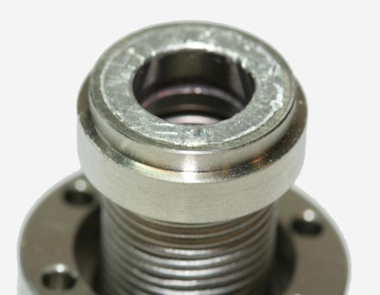Sealing with Indium

Sealing with Indium
Indium creates effective
and reliable helium tight hermetic seals between metals or non-metallics like
glass and ceramics. For example, indium can
be used to seal non-wettable surfaces in cryogenic applications, vacuum pumps
and in heat-sensitive areas.
When indium is used as
the sealant, a chemical bond is formed between this silvery, semi-precious
metal and the surfaces to be mated. Gaskets made from other materials only form
a barrier to the medium being contained. Indium seals are far less sensitive to
mechanical shock, vibration and low temperatures than other types of seals.
A characteristic of
indium is that it forms an oxide film on its surface. In order to present clean
indium metal to a substrate, this film must be broken by compression and
plastic deformation. Only by breaking the oxide film is it possible to obtain a
chemical bond between indium and another surface without the use of heat. This
process is easy to accomplish since indium readily flows under pressure, even
at cryogenic temperatures.
The Quality of an Indium Seal Depends Upon:
►The purity and the cleanliness of the Indium used. 99.99% is the preferred purity although some very critical applications call for 99.999% purity. Pretreatment of the seal is not usually necessary, but heavy contamination with organic compounds should be removed by degreasing. Surface oxide can be etched off by using 50% hydrochloric acid (a 2-4 second dip) followed by rinsing in deionized water.
►Surface Preparation. All surfaces must be clean and dry. Glass and ceramic surfaces must be cleaned with a mixture of chromic and sulfuric acids followed by hydrochloric acid and deionized water to a high polish. Drying can be done in an oven or by passing through a gas flame. In super-clean applications, cleaning is done by bombarding with ultra-violet light or with an electrical plasma. Metal surfaces can be bare, pre-tinned with indium or plated with indium or silver. Bare surfaces can be polished using very fine abrasive powders or can have a fine, machined finish. Fine machine finishes should not be "improved" using abrasive powders, cloths, etc.
► Thickness and
shape of Indium. While some flat seals can be as thin as 0.008" (0.2 mm), other applications call for
0.062" (1.6mm)
thick material. Indium seal thickness depends upon the area of the mating
surfaces and the compressive force on the seal. If the seal is placed in an 'O'
ring groove, the seal should be sized so that when it is compressed it
overfills the groove by 5 - 15%. In some applications, overlapping segments of
indium can perform as well as a continuous washer. Correctly formed seals have
leak rates of less than 2 x 10-7 torr x liter / sec.
